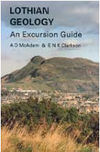North Esk Inlier, Gutterford Burn - an excursion

By G. Robertson. From: Lothian geology an excursion guide. Edited by A.D. McAdam and E.N.K. Clarkson. 1996
O.S. 1:50000 Sheet 65 Falkirk and West Lothian
B.G.S. 1:50000 Sheet 32W Livingston
Introduction
Silurian rocks outcrop in three inliers in the Pentland Hills. The largest of these, the North Esk Inlier, forms the subject of this excursion. The others are the Bavelaw Castle and Loganlea-Craigenterrie inliers (p. 162). Silurian strata in the inliers are generally vertical though rarely gently inclined. They strike SW-NE, young NW and are overlain with angular unconformity by gently dipping Lower Old Red Sandstone greywacke conglomerates. Silurian fossils were first recorded from the Pentlands by McLaren in 1838. Since then local geologists have collected extensively from the inliers. the most prominent being Hardie and Henderson, whose large collections made last century are in the Royal Museum of Scotland. Originally the sediments were thought to be of Wenlock to Downtonian age (Peach & Horne, 1899). However, in an extensive reinvestigation of the fauna, Lamont (1947) determined ages ranging from Upper Llandovery, probably crellulata biozone, to Wenlock for the North Esk Group as exposed in the North Esk Inlier. These ages were incorporated in the third survey by the Geological Survey (Mykura & Smith in Mitchell & Mykura 1962) and are generally accepted by later workers.
The succession as given by Tipper (1976) and Robertson (in prep.) is as follows, with the localities to be visited numbered:
| metres | |
| North Esk Group | |
| Henshaw Formation (?Wenlock) (16-17, 26-29) | |
| Red conglomerates, cross-bedded micaceous sandstones, olive green shales with one or two bands of fish fragments | 730 |
| Wether Law Linn Formation (Llandovery) (11-15, 25, 30) | |
| Well-laminated brown siltstones with shelly fauna | 125 |
| Poorly stratified brown sandy siltstones | 45 |
| Highly fossiliferous laminated and bioturbated yellow-brown silty mudstones | 40 |
| Cock Rig Formation (Llandovery) (10) | |
| Cross stratified red-brown conglomerates and sandstones | 110 |
| Deerhope Formation (Llandovery) (6-9) | |
| Fossiliferous blue-grey micaceous siltstones and mudstones | 250 |
| Reservoir Formation (Llandovery) (1-5, 18-24) | |
| Interbedded greenish sandy siltstones and mudstones | 1400 |
The sequence represents a rapid regression from an offshore submarine fan environment (Reservoir Formation, Deerhope Formation and Cock Rig Formation) through a shallow shelf environment in which an abundant and diverse fauna existed, though changing through time (Wether Law Linn Formation) to a terrestrial environment (Henshaw Formation). The most recent bibliography of works on the fossils of the Pentland Hills is given by Clarkson & Howells (1981).
Carlops and West Linton can both be reached by Eastern Scottish service buses. For access to the eastern part of the inlier (Excursions A and B) coaches should be left in Carlops and the 3 km walk taken either by the east bank of the River North Esk or by the farm track to Fairliehope and to the cottage at the reservoir. Private cars may be parked near the cottage. The western end of the inlier (Excursion C) can be reached from West Linton by following the road to Baddinsgill Reservoir where a public car park is provided 1 km from the reservoir. The itinerary forms the basis for one day and two half-day excursions. They are:
- River North Esk
- Gutterford Burn
- Lyne Water
Gutterford Burn
